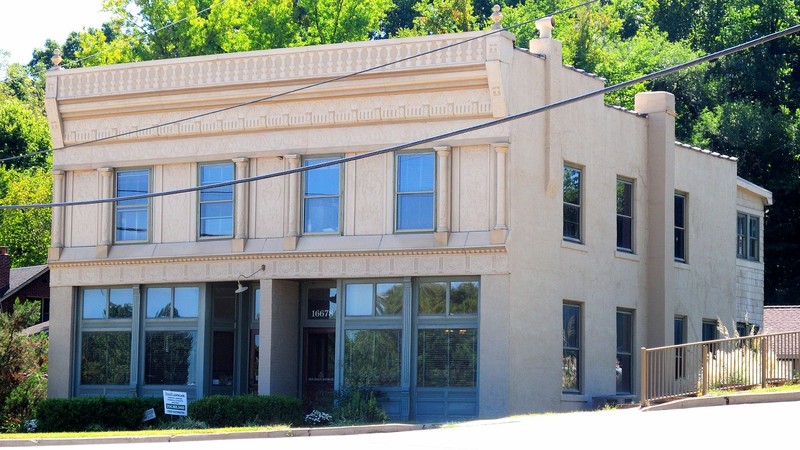Farmers State Bank
Introduction
Text-to-speech Audio
This historic bank was built in 1914 and serves as a reminder of Chesterfield's development at this time when the future Saint Louis suburb was tied to the railroad. Chesterfield did not incorporate as a city until 1988, but its origins as a settlement pre-date the Louisiana Purchase. Six distinct communities, including the original Chesterfield town, developed in the area during the early nineteenth century and eventually consolidated into Chesterfield by the twentieth century. One significant stage of development occurred during the 1870s when the railway came into town, and German immigrant Christian Burkhardt purchased twenty-one acres (1877) near the rail lines to develop Burkhardt's Subdivision. Christian's son, Edward, continued to invest in Chesterfield, including building homes, opening a mercantile store in his name, and founding (and constructing the structure for) the Farmers State Bank of Chesterfield in 1914. Today, the Farmers Building is the oldest commercial structure in Chesterfield and the only surviving rural bank building in St.Louis County.
Images
Farmers State Bank

Backstory and Context
Text-to-speech Audio
Within Chesterfield's present city limits, there exist the remnants of six towns, all once supporting individual post offices until, one by one, post offices closed, leaving the Chesterfield post office as the only one in operation. The towns included Bellefontaine (1837), Lake (1850), Gumbo (around 1882), Monarch (late 1870s), Bonhomme (possibly as early as 1815), and the original town of Chesterfield developed in 1817 by Col. Justus Post (although the town plat did not materialize until 1838). However, before the creation of those six towns commenced, settlement in the area dates back to the 1790s, and Europeans and Native Americans worked and lived in the area in the decades and centuries before that; the region has undergone numerous transitions.
In 1877, shortly after the arrival of the Chicago, Rock Island, and Pacific Railway, Christian Burkhardt, one of the many German immigrants in Missouri, acquired twenty-one acres near the railroad stop. He created Burkhardt's Subdivision near the railroad, helping turn Chesterfield into a railway suburb of St. Louis. He died in 1898, but his son Edward and Edward's wife Lena continued to invest in Chesterfield's development, including building the Farmers State Bank Building; he founded and managed the bank. Edward also developed Burkhardt Place, a row of dozen bungalows constructed between 1918 to 1925, and he opened a mercantile store and hotel in his name, strategically located next to the train station. The Farmers State Bank Building also housed the post office (Edward served as postmaster) and telephone switchboard. Seemingly, one would have been hard-pressed to find anything in Chesterfield that Edward Burkhardt didn't run or at least partially own by the early 1900s.
As the name suggests, Burkhardt and his business partners opened the Famrer's Bank, intent on catering to farmers. Although close to St. Louis, the Chesterfield area lay close to rural lands, and farming had evolved into a profitable business; good soil became a booming commodity. Burkhardt served as bank president until 1923, and during that time, he oversaw the bank's assets grow substantially, from $34,000 in 1915 to nearly $180,000 by the mid-1920s. The bank continued to prosper after Burkhardt left, even surviving the Great Depression (and concurrent "Dust Bowl" era); assets eclipsed $500,000 by the end of World War II.
The bank finally left its historic building in the mid-1950s. It wasn't until the 1960s that Chesterfield saw another step in its evolution. In the '60s, Louis Sachs began developing Chesterfield Village, consisting of 1,200 acres marked by condominiums, apartments, and office buildings surrounding a large, regional shopping mall. Twenty years later, in 1988, Chesterfield Village was incorporated as a city.
Chesterfield Village spurred much growth in the community, leading to incorporation as a city on June 1, 1988, roughly 110 years after Christian Burkhardt and the railway arrived and almost seventy-five years after the Farmers State Bank opened. The building survives as a reminder of the town's early history, the impact German immigration had in Missouri, the influence of the railroad on suburban development, the link between farms and growing cities around the turn of the century, and of course, the influence of the Burkhardt's on the area.
Sources
Gellman, Mark. "Chesterfield: A City of Towns." The Gellman Team. September 17, 2021. https://www.thegellmanteam.com/blog/chesterfield-a-city-of-towns/#:~:text=Chesterfield%20was%20first%20settled%20in,near%20the%20railroad%20on%20Olive.
Olson, Audrey L. "St. Louis Germans, 1850-1920: The Nature of an Immigrant Community and its Relation to the Assimilation Process." Ph.D. Dissertation, University of Kansas. 1970.
Rothwell, Dan Allen. "Historic Families of Chesterfield." City of Chesterfield. Accessed May 31, 2023. https://www.chesterfield.mo.us/history.html.
Sheals, Debbie. "Registration Form: Farmers State Bank of Chesterfield. National Register of Historic Places." mostateparks.com. 1999. https://mostateparks.com/sites/mostateparks/files/Farmers%20State%20Bank%20of%20Chesterfield.pdf.
Thomas, William Lyman. History of St. Louis County, Missouri. Volume 1. St. Louis: The S. J. Clarke publishing co., 1911. Transferred to digital format in 2007 and maintained by the Missouri County Histories Collection at https://mdh.contentdm.oclc.org/digital/collection/mocohist/id/11453.
By Mark Ravenscraft - Own work, CC BY-SA 3.0, https://commons.wikimedia.org/w/index.php?curid=28480710
